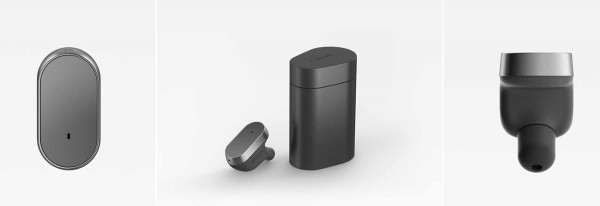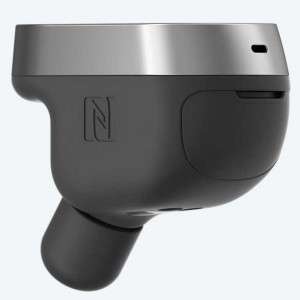
If Sony’s product roadmap holds, we’ll be given two more voice-driven devices sometime in 2017: the Xperia Agent and Xperia Projector. Until that time, the best example we have of Sony’s ambitions towards AI and voice-enabled products is the just-released Xperia Ear, their competitor for – or take on – the Apple AirPods. As Alistair Charlton from the International Business Times writes in his Xperia Ear review, you start off with a lot of slick tech.
The Ear comes with a lovely charging case with a spring-loaded lid and a snug pocket for the Ear to sit in, where it recharges from the case’s own battery, which in turn is charged via a microUSB port. There is no on button; you just take out the Ear, wear it and it starts working via a Bluetooth connection to your Android phone.
But before we even dive into its functionality and what it can do, the most profound knock against the Xperia Ear is its comfort level and no matter how amazing the technology behind it is, if you can’t bear to keep it in your ear, the entire thing becomes pointless.
Firstly, it is uncomfortable. We had to remove it frequently because our ears began to ache, and although changing the rubber tip and a second rubber piece to keep the Ear in place helped, we could never quite ignore it. The discomfort is intensified every time you interact with the Ear, because you have to press a button to make it listen, which means pushing it against your ear.
I’ve been running around with AirPods which go in both ears for the better part of a week and most often, I keep them in for at least 4 hours a day if not longer. The moral of this is because of how comfortable they are, I’d tend to forget they’re in my ear until I needed to use them and that’s how any wearable, be it a watch or an ear-based device, needs to be. But if we tuck aside comfort for a minute and say that the target audience for Xperia Ear is early adopters who are willing to literally put up with the pain of the tech to gain its functionality, do we then have something that’s worthy?
The assistant says hello (sometimes with your name, but usually, inexplicably, without) and reads the day’s news headlines each time you start wearing the Ear, but these headlines, plucked from Sony’s News Suite app, are completely random and sometimes not news stories at all. On the day of writing this she read the title of a feature marking the one-year anniversary of the San Bernardino terror attack. With no way to hear more of the article or open it to read on our phone, this felt completely pointless.
Even more pointless is the glowing white light on the outside of the Ear. Who is this light for? Why is the wearer being notified by a light which is half an inch from their ear and thus completely out of sight? Maybe it’s to tell bystanders they are being ignored because I’m listening to an email.
 As for functionality, Xperia Ear can tap into quite a few stock apps with hit or miss results like weather, headlines, and directions which is quite nice for larger cities.
As for functionality, Xperia Ear can tap into quite a few stock apps with hit or miss results like weather, headlines, and directions which is quite nice for larger cities.
Directions also work quite well. Ask for “directions to Manchester” and the Ear will ask if you want to travel by car, public transport or walking. Give your answer and within a couple of seconds the directions appear on your phone.
In addition, there is also support for third party apps but those don’t always pan out too well. To be fair, if third party apps are problematic, assuming Sony has put out adequate APIs, whatever fault exists should rest upon the developers’ shoulders.
Facebook Messenger is less successful. Ear quickly starts reading out messages when they arrive, stating the person’s name followed by their message (or chat name, person’s name, message for group conversations). But if the same person sends a second message before you open the conversation on your phone, Ear will immediately read the first message again, followed by the second, even if they were sent within seconds of each other.
Fail to read your messages for a few hours and it becomes a complete mess, reading out an entire conversation when a single new message arrives. Why should I need to open the app and read the message, when I’ve had it read to me? That’s the only way to stop Ear reading multiple messages over and over again. And another question: who would switch on the feature where you can nod or shake your head to interact with the Ear? It feels like something out of Black Mirror.
In order for Xperia Ear to be a useful and a must-buy device, it first has to become invisible – this is in regards to both comfort which is in part due to design, and functionality. If you have to think too often what you can or cannot do with it or keep hitting barriers with it, the whole thing falls apart quickly, even for earlier adopters, let alone a product that hopefully attracts the masses which begs the question, who is the Xperia Ear meant for?
As you can probably tell by now, our time using the Xperia Ear was not always an enjoyable one. The Ear can be used to play music but listening to songs through a single Bluetooth earpiece seems a waste of time. And while listening to a one-line description of topics provided by Wikipedia might be occasionally useful, the feature feels like a fringe case at best.
This also sums up the Xperia Ear generally. It is a device with limited use and which will only appeal to a very small group of consumers; and even targeting this group of tech-loving early adopters, it is unlikely many will see the £179 price tag as good value.
Chances are that I’d be far less willing to wear my AirPods if they didn’t provide stereo sound. Thanks to iCloud and Handoff, I am able to easily work on my iMac editing videos for CES and slide into bed with my iPad at night without disturbing Allegra as they easily transition sound from one device to another. If AirPods instead were just a mono unit like the Xperia Ear, there’s no way I’d have them on throughout the day when I’m home because all extra functionality aside, which can be triggered by invoking Siri, the AirPods are just good wireless headphones to have.
 The Xperia Agent can never be that which means it must excel at being a headset and if the additional functionality it provides via voice is mess, then all you’re left with is an expensive Bluetooth headset. Now I should stress that Sony needs to play in this space. As computers continue to shrink down, wearables will be the future though it’s unclear if it will be via a singular device like the watch or headset or if it will be a combination, but AI-driven wearables will eventually become as ubiquitous as the smartphone.
The Xperia Agent can never be that which means it must excel at being a headset and if the additional functionality it provides via voice is mess, then all you’re left with is an expensive Bluetooth headset. Now I should stress that Sony needs to play in this space. As computers continue to shrink down, wearables will be the future though it’s unclear if it will be via a singular device like the watch or headset or if it will be a combination, but AI-driven wearables will eventually become as ubiquitous as the smartphone.
Still, it’s always been clear to me that the Xperia Ear wasn’t ready for primetime – which begs the question, is this purely a learning experience for Sony as they gain invaluable knowledge and data from the Ear’s release which ranges from production to consumer reaction, or is this a sign of the old Sony rearing its head out by releasing a product for a given market without putting the time and nuances required for it to succeed?
Alistair ends his Xperia Ear review with:
The Sony Xperia Ear is a poorly thought-out solution to a problem that doesn’t exist. It is easy to criticise millennials for staring into their smartphones all day, but suggesting a device like the Ear will encourage them to look up, see the beauty of mother nature and enjoy life more is short-sighted.
Apart from the cool and beautifully designed charging case, the Xperia Ear is simply frustrating. It lacks any form of wow factor and doesn’t offer any real benefits over talking to Siri or Google Now through the headphones you are already using. The Ear would probably look good on the set of a sci-fi film, but in the real world it just doesn’t make sense.
I’m curious to your experience with wearables like this, be it the Xperia Agent or AirPods.

You must be logged in to post a comment.